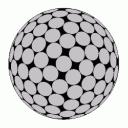Yahoo Answers is shutting down on May 4th, 2021 (Eastern Time) and beginning April 20th, 2021 (Eastern Time) the Yahoo Answers website will be in read-only mode. There will be no changes to other Yahoo properties or services, or your Yahoo account. You can find more information about the Yahoo Answers shutdown and how to download your data on this help page.
Trending News
2 Answers
- atsuoLv 66 years agoFavorite Answer
p,q,r are distinct prime numbers , so assume that p < q < r .
I found only one solution p,q,r = 13,29,43 .
Let P = p-1 , Q = q-1 and R = r-1 . P < Q < R and 1/P + 1/Q + 1/R = 1/7 .
1/R = 1/7 - (1/P + 1/Q)
..... = 1/7 - (P+Q)/(PQ)
..... = PQ / (7PQ) - 7(P+Q) / (7PQ)
..... = [PQ - 7(P+Q)] / (7PQ)
R = 7PQ / [PQ - 7(P+Q)]
If we decide P and Q , then we can find the value of R . But r = R+1 must be a prime number .
P and Q can be only 1,2,4,6,10,12,16,18,22,28,30, .... (prime numbers - 1)
If P is 6 or less , then 1/P > 1/7 . So we let P = 10 and start to check the value of R .
Minimum value of Q is 28 . ( If Q is 22 or less , then 1/P + 1/Q > 1/7 . )
P ..... Q ..... R
10 ... 28 .... 140 ...... r = R+1 = 141 is not a prime number .
10 ... 30 .... 105 ...... r = R+1 = 106 is not a prime number .
10 ... 36 .... 66.3 ..... R is not an integer .
10 ... 40 .... 56 ........ r = R+1 = 57 is not a prime number .
10 ... 42 .... 52.5 ..... R is not an integer .
10 ... 46 .... 47.35 ... R is not an integer .
10 ... 52 .... 42.32 ... Q > R , so we can finish to check the value of R with P = 10 .
Next , we let P = 12 and start to check the value of R .
Minimum value of Q is 18 . ( If Q is 16 , then 1/P + 1/Q > 1/7 . )
P ..... Q ..... R
12 ... 18 .... 252 ...... r = R+1 = 253 is not a prime number .
12 ... 22 .... 71.07 ... R is not an integer .
12 ... 28 .... 42 ........ r = R+1 = 43 is a prime number . ---> p,q,r = 13,29,43 is a solution .
12 ... 30 .... 38.18 ... R is not an integer .
12 ... 36 .... 31.5 ..... Q > R , so we can finish to check the value of R with P = 12 .
Next , we let P = 16 and start to check the value of R .
P ..... Q ..... R
16 ... 18 .... 40.32 ... R is not an integer .
16 ... 22 .... 28.65 ... R is not an integer .
16 ... 28 .... 22.4 ..... Q > R , so we can finish to check the value of R with P = 16 .
Next , we let P = 18 and start to check the value of R .
P ..... Q ..... R
18 ... 22 .... 23.89 ... R is not an integer .
18 ... 28 .... 19.38 ... Q > R , so we can finish to check the value of R with P = 18 .
If we let P = 22 , then the minimum value of Q and R is 28 and 30 . But
1/22 + 1/28 + 1/30 = 0.1145... < 1/7 , no solution exists .
And clearly if P > 22 then no solution exists .
- ?Lv 76 years ago
1/(p-1) + 1/(q-1) + 1/(r-1) = 1/7
(q-1)(r-1) + (p-1)(r-1) + (p-1)(q-1) = (p-1)(q-1)(r-1) / 7
(qr - q - r + 1)+(pr - p - r + 1) + (pq - p - q + 1) = (p-1)(q-1)(r-1) / 7
qr + pr + qp - 2p - 2q - 2r + 3 = (p-1)(q-1)(r-1) / 7
7qr + 7pr + 7qp - 14p - 14q - 14r + 21 = (p-1)(q-1)(r-1)
Now expand the right-hand side and solve



